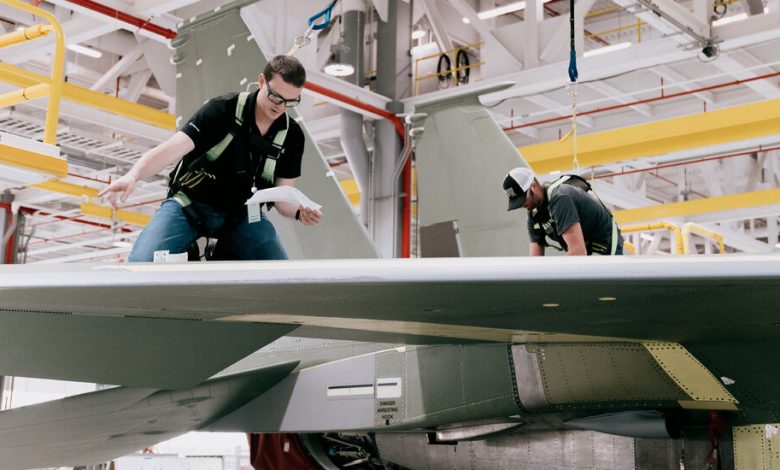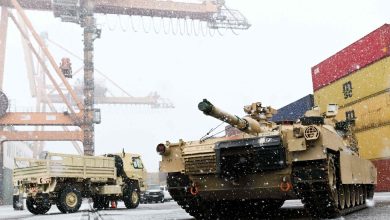Middle East War Adds to Surge in International Arms Sales

Just days after the assault by Hamas ignited a new war in the Middle East, shipments of American weapons began arriving in Israel: smart bombs, ammunition and interceptors for the Iron Dome missile-defense system. When President Biden meets in Israel on Wednesday with Prime Minister Benjamin Netanyahu, more military aid is a likely topic.
The conflict between Israel and Hamas is just the latest impetus behind a boom in international arms sales that is bolstering profits and weapons-making capacity among American suppliers.
The surge in sales is providing the Biden administration with new opportunities to tie the militaries of other countries more closely to the United States, the world’s biggest arms exporter, while also raising concerns that a more heavily armed world will be prone to careen into further wars.
Even before Israel responded to the deadly Hamas attack, the combination of Russia’s invasion of Ukraine and the perception of a rising threat from China was spurring a global rush to purchase fighter planes, missiles, tanks, artillery, munitions and other lethal equipment. The surge in sales is also being driven by the rapid pace of technological change in warfighting, pressuring even well-armed nations to buy new generations of equipment to stay competitive.
The push to supply more weapons to Israel comes as American military contractors are already struggling to keep up with demand to resupply Ukraine in its war against Russia and help other U.S. allies in Europe like Poland bolster their own defenses.
Billions of dollars in orders are pending from allies in Asia, driven by the perception of a rising threat from China.
Worldwide military spending last year — on weapons, personnel and other costs — hit $2.2 trillion, the highest level in inflation-adjusted dollars since at least the end of the Cold War, according to the Stockholm International Peace Research Institute, which prepares an annual tally.

Israeli soldiers preparing to move a tank toward Gaza last week. The conflict between Israel and Hamas is just the latest impetus behind a boom in international arms sales.Credit…Sergey Ponomarev for The New York Times
One of the biggest drivers is the increased purchase of new weapons systems.
Excluding sales within the United States, China and Russia, worldwide spending on military procurement is expected to hit $241 billion next year, a 23 percent increase since last year even after adjusting for inflation.
That is by far the largest two-year increase in the database maintained by Janes Defense, which has been tracking military spending for nearly two decades.
As of last year, the United States controlled an estimated 45 percent of the world’s weapons exports, nearly five times more than any other nation and its highest level since the years immediately following the collapse of the Soviet Union, according to the data. That is up from 30 percent a decade ago.
The intense demand for more military firepower has also encouraged other arms-producing nations, like Turkey and South Korea, to increase their exports, giving purchasers more options at a time when production shortfalls in the United States mean it can take years for orders to be filled.
Some of the big purchasers, like Poland, a NATO ally that fears further Russian aggression, are arming themselves more heavily to confront specific threats. Others, like Indonesia, once a customer of Russia that is now moving to buy more from the West, are trying not to fall behind in regions undergoing rapid militarization. And nations in the Middle East, from Israel to Saudi Arabia, continue to be major buyers of American weapons, orders that will only now jump again with the new war.
The surge in weapons purchases has caused growing concern about the potential for conflicts to become more likely, and more deadly, beyond the wars that already are underway in Europe and the Middle East.
“We live in a very fragile world, where there are many unresolved conflicts,” said Michael Klare, a board member at the nonprofit Arms Control Association. He pointed to tensions between Pakistan and India, or between Azerbaijan and Armenia, all of which have increased recent military equipment buys.
“There is a risk these arms sales will exacerbate a regional conflict,” he said, “and trigger the outbreak of war among the great powers ultimately.”
For the big military contractors, the surge has bolstered their bottom lines.
Pentagon notifications to Congress of proposed government-to-government foreign military sales surpassed $90.5 billion in the first nine months of this year, exceeding the pace of an annual average of about $65 billion over the prior decade, according to data tallied by the Forum on the Arms Trade.
And government sales are just one portion of the global arms trade, with direct sales from military contractors comprising the bulk of the business. Last year, the $51.9 billion in foreign military sales that flowed through the Pentagon represented just a third of the $153.7 billion in authorized direct sales of weapons, military parts and services by the United States to overseas buyers, including Ukraine.
“Lots of good news out there,” Gregory J. Hayes, the chief executive of RTX, whose Raytheon division is one of the world’s largest suppliers of missile systems, said during a Wall Street briefing in April. “And for us, it’s just a question of getting it out the door at this point.”
The push to modernize military arsenals has also created one of the most consequential diplomatic pushes since World War II by the U.S. government to expand military alliances.
The United States is beginning to make inroads with new customers like India and Indonesia, taking them away or weaning them from Russia or China, while selling more to existing allies and buyers. Purchases of American-made weapons systems typically require close coordination with the U.S. military and long-term contracts for maintenance and upgrades that help to build ties.
“We have a moment of opportunity right now,” said Mira K. Resnick, a deputy assistant secretary at the State Department, which is the lead agency approving foreign military sales. “One of the ways that we can effect strategic failure for Russia is by cutting the Russian defense industry off of its security partners.”
Demand from Europe and Asia
Nowhere outside of Ukraine is the race to buy more apparent than in Poland, opening opportunities not just for the major American contractors but also those of other nations.
President Andrzej Duda announced last month at a military industry-sponsored trade conference that his country is going to spend more than 4 percent of its gross domestic product on defense, or twice the goal agreed to by NATO nations.
Since January, Poland has been granted the right to buy $41.7 billion in weapons from the United States, including Lockheed Martin’s HIMARS and Hellfire missile systems ($10 billion), Raytheon’s Integrated Air and Missile Defense system ($15 billion) and 96 of Boeing’s Apache attack helicopters ($12 billion). These are in addition to the Abrams tanks built by General Dynamics and F-35 fighter jets from Lockheed Martin that Poland has ordered in recent years.
Poland’s minister of defense, Mariusz Błaszczak, climbed onto a stage one recent Sunday in front of a crowd at a military training ground outside Warsaw to get a firsthand look at a new generation of tanks, helicopters, missiles and drones.
“Today we can admire modern equipment, modern weapons of the Polish Army, weapons that we obtained through the implementation of arms contracts,” Mr. Błaszczak said.
Poland has decided it needs so many new weapons, so fast, that American contractors simply cannot deliver the items fast enough, officials in Poland said.
As a result, it has also turned to nations like South Korea and Turkey that have worked to expand their own weapons sales.
Last year Poland reached a $14 billion agreement with South Korea as it plans to buy as many as 1,000 tanks, 48 fighter jets and 672 self-propelled howitzers. That order by Poland alone is larger than all of the tanks now in the militaries of Germany, Britain and France combined.
When Lockheed, working through a huge backlog of orders, could not deliver missiles on a timetable sought last year by Poland, Mr. Błaszczak said he turned to South Korea for missile launchers that are similar to Lockheed’s HIMARS system.
The first of the South Korea-made missile launchers arrived in Poland in August, less than a year after the deal was signed. Lockheed took four years to deliver the first of its HIMARS missile launchers to Poland, which signed a deal for them in 2019. Lockheed declined requests to comment.
“Russia’s invasion of Ukraine is reshaping spending priorities, driving nations to better prepare for existing and future threats,” Vince Logsdon, a retired Air Force colonel now at Boeing, which recently pitched Poland to buy a new fleet of its F-15EX fighter jets.
Poland has also added Turkey to its list of weapons suppliers, buying armed drones made by Baykar, a former automotive parts company turned military contractor, which delivered the first of them last year.
Turkish drone makers in recent years has sold their devices to at least 29 nations and been used in war zones in Libya, Syria, Ethiopia, Somalia and Azerbaijan, according to Soner Cagaptay, a researcher at the Washington Institute for Near East Policy.
“Turkey is mapping its power globally through the sale of weapons,” Mr. Cagaptay said, noting that it is now the world’s 11th largest arms dealer, up from 18th a decade ago.
The Biden administration’s push to capitalize diplomatically on the demand for U.S.-built weapons has been particularly notable in Asia, where Washington has been working to bolster alliances as a counterweight to China’s expanding power.
Indonesia is now considered a big prize, which explains in part why Defense Secretary Lloyd J. Austin III visited there last year to push the nation to buy Boeing-built F-15 fighter jets.
Indonesia had signed a contract in 2018 to buy Russian Sukhoi Su-35S fighter jets. It later backed out of that deal and looked instead to the West: It recently moved to buy fighters from France and now has a tentative deal to buy F-15s, which are made in St. Louis. Indonesia also announced plans to buy Blackhawk helicopters from Lockheed Martin.
Military equipment deals by the United States during the Biden administration have also been discussed or signed with Vietnam, the Philippines, Singapore, South Korea, Australia and Japan, and even with some small Pacific island nations. Taiwan alone has a backlog of American weapons orders worth as much as $19 billion.
The weapons sales in the Middle East are only adding to the demand.
In the days after the attacks by Hamas in Israel, Mr. Biden announced that the United States was already moving to send additional ammunition and Iron Dome interceptor missiles made by Raytheon and Rafael, a French military contractor.
New shipments of small, 250-pound guided bombs made by Boeing are also being sent to Israel, as are additional gear that converts older, crude bombs into precision-guided “smart” munitions.
The United States already provides Israel more than $3 billion in military assistance every year, but Congress could move soon to increase funding. Israel has asked the United States for $10 billion in emergency aid, according to three officials familiar with the request, though it is not clear how much would be for weapons and munitions.
“We’re going to make sure that Israel does not run out of these critical assets to defend its cities and its citizens.” Mr. Biden said.
Even more weapons could soon be headed to Saudi Arabia, which already is the single biggest buyer of U.S. weapons (its purchases through the Pentagon since 1950 total $164 billion). Over the past two years, it has requested permission to buy billions of dollars more, including a proposed order last month for parts needed to keep its American-made tanks and weapons systems operating.
Jeff Abramson, an arms control advocate at the Center for International Policy, said the surge in sales will resonate long after the wars in Europe and the Middle East end.
“The history of the arms trade is one filled with dangerous unexpected results,” he said. “We tend to forget that weapons have a long life and often end up in the hands of those we did not intend or want to have them.”
The Challenge of Capacity
The boom in sales will help the Pentagon confront a weakness apparent after Russia invaded Ukraine in February last year: the capacity of the defense industrial base in the United States to produce weapons fast enough at a time of intensified superpower tensions.
The increase in demand is providing weapons makers confidence that they can count on sustained orders to increase production and assure that the U.S. industry remains robust. Contractors have taken some initial steps to add shifts and equipment.
International sales are now so strong that Raytheon, the military division of RTX Corp., expects that a third of all of its weapons sales will be to international customers by 2025, up from about 25 percent last year.
The orders now being tallied by U.S. military contractors will generate work for years. Lockheed, the world’s largest military contractor, in the past two years has secured approval or sales agreements worth as much as $50 billion for its F-35 fighter jets with Switzerland, Finland, Germany, Greece, Czech, Canada and Korea.
These orders have a direct impact on factories in the United States, including Boeing’s F-15 fighter jet plant in St. Louis, which could soon be building planes for Indonesia and perhaps Poland.
The Pentagon and the State Department have been working this year to find ways to accelerate approval of foreign military sales to keep up with the rising global demand.
But the main bottleneck remains manufacturing capacity.
“We need an industrial base that meets these requirements,” said James Hursch, director of the Defense Security Cooperation Agency, which oversees foreign military sales along with the State Department. “Everyone involved — allies, partners, industry — all know this is a major challenge.”





